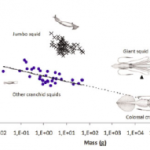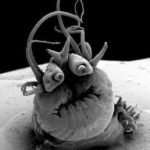An occasional series where we briefly report 3 new studies and tell you why they are cool!

The western Pacific is broken land, plates are crashing every which way creating earthquakes and volcanoes from Russian Kamchatka to New Zealand. At these volcanic arcs exist a unique and abundant flatfish at hydrothermal areas. Symphurus thermophilus was described as one species along the entire western Pacific volcanic arcs, which begged the study that Tunnicliffe and colleagues did – study how divergent population of this species are! The authors used 2 genes, COI and 16S, both commonly used in population genetics studies, on Symphurus species from near Japan and near New Zealand. They found that between those individuals inhabiting the Mariana Arc and those inhabiting the Tonga-Kermedec arc, population were diverged by 9% and 14% for COI and 16S, respectively. Previous Barcode of Life projects found 3% (butterflies) to 9-10% (fishes) divergence to be sufficient for delimiting new species. Within each arc system, populations appeared to be well-mixed, but there are indeed migrants between arcs.
Why is this study cool? Besides their barcoding of the vent flatfish from Japan and New Zealand vent, they used a real integrative approach with morphology, gut contents, ecology and behavior to conclude that this is likely to be 2 or 3 species total.
Tunnicliffe V, Koop BF, Tyler J, So S (2010) Flatfish at seamount hydrothermal vents show strong genetic divergence between volcanic arcs. Marine Ecology doi:10.1111/j.1439-0485.2010.00370.x
 This paper by Milner and colleagues studied whether male fiddler crabs could sense there were receptive females around when they could no see them by observing the courtship displays of neighboring crabs (the fiddler crab claw wave). In a simple, but elegant, experiment they placed a barrier in front of the males so they could not see if receptive females were present or not. They found that the number of claw waves by males increased (see graph on left) in the presence of females with or without barriers. This means that they were eavesdropping on the courtship behavior of their neighbors in order to prepare themselves for waving their arms about madly to attract the opposite. Sound familiar?
This paper by Milner and colleagues studied whether male fiddler crabs could sense there were receptive females around when they could no see them by observing the courtship displays of neighboring crabs (the fiddler crab claw wave). In a simple, but elegant, experiment they placed a barrier in front of the males so they could not see if receptive females were present or not. They found that the number of claw waves by males increased (see graph on left) in the presence of females with or without barriers. This means that they were eavesdropping on the courtship behavior of their neighbors in order to prepare themselves for waving their arms about madly to attract the opposite. Sound familiar?
Why is this study cool? OK, let’s be honest here, I picked this article because of the title: “Eavesdropping in crabs: an agency for lady detection”. WIN!
Milner RNC, Jennions MD, Backwell PRY (2010) Eavesdropping in crabs: an agency for lady detection. Biology Letters. doi:10.1098/rsbl.2010.0384
———————————-

Is it a coincidence that there were mass die-offs of urchins off Nova Scotia after 2 eastern US hurricane landfalls? Scheibling and colleagues find it curious at least and show interesting data correlating the timing of two hurricanes and the urchinicide, which occurred 2-3 weeks after the hurricanes made landfall. They found that disease-causing amoebas were present in dying urchins, confirmed it by taking urchins form colder waters, a more harsh environment for the Paramoeba to develop in, and exposing them to water from infected urchins. All urchins died off between 17 and 21 days from all treatments.
Why is this study cool? They show that “… hurricane-induced mixing can deliver a nonresident pathogenic agent to the Atlantic coast of Nova Scotia.” If a pteropod flaps its mantl “wings” off of Florida is there a mass urchinicide in Canada?
Scheibling RE, Feehan C, Lauzon-Guay J (2010) Disease outbreaks associated with recent hurricanes cause mass mortality of sea urchins in Nova Scotia. Mar Ecol Prog Ser 408:109-116. doi:10.3354/meps08579
Share the post "The Tide Pool: Divergent Flatfish, Eavesdropping Fiddler Crabs, Hurricanes Kill Urchins"






It is so cool to see new species emerging!